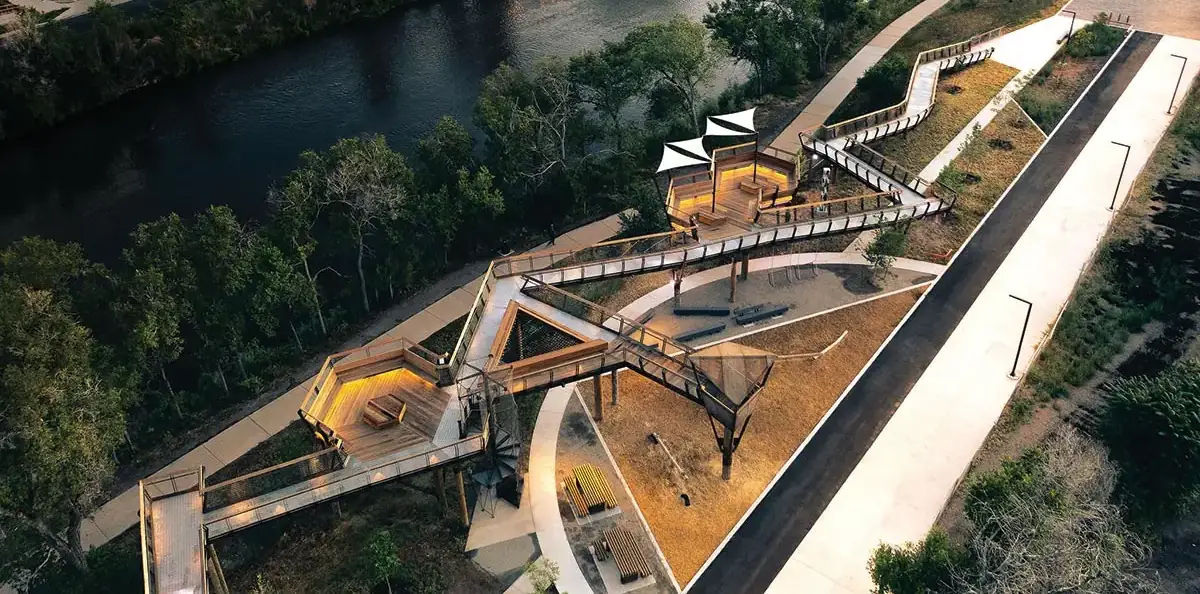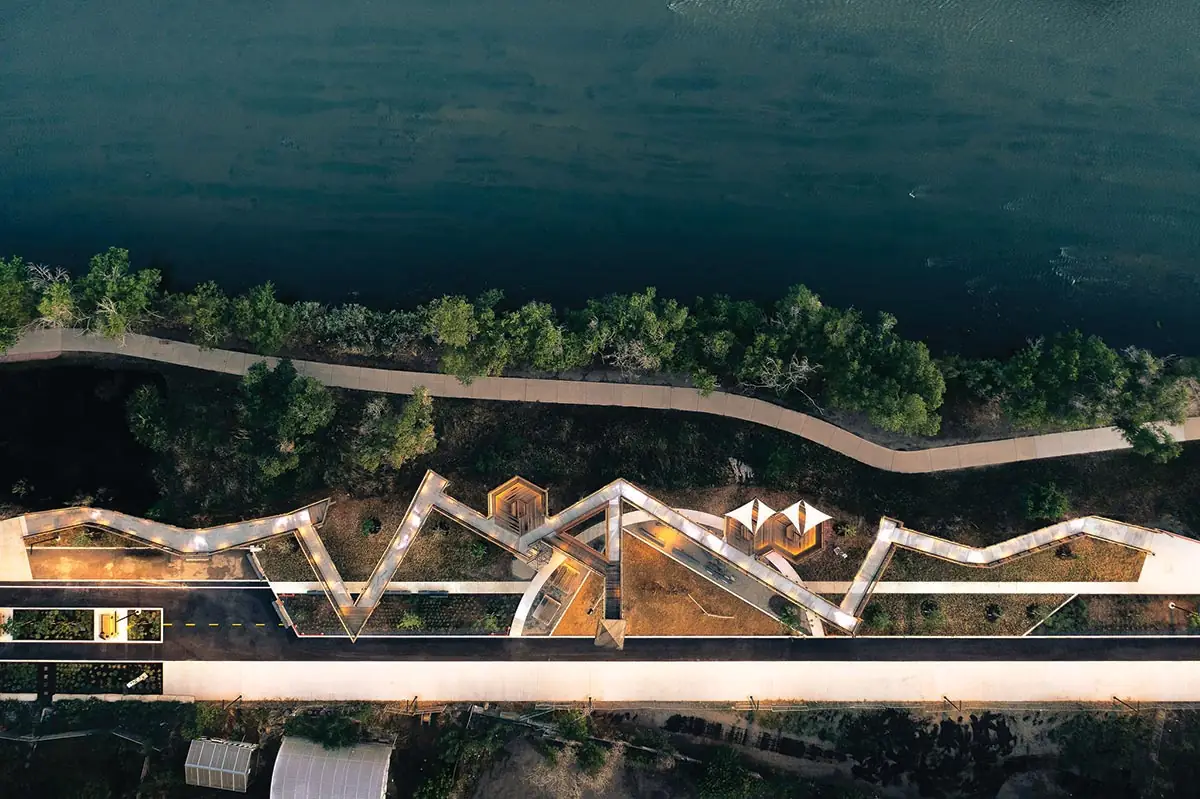An elevated ribbon of walkway appears to float through existing and newly planted native trees and shrubs along the South Platte River in Denver. Conceived by local landscape architecture firm Wenk Associates and Tres Birds architecture studio, Arkins Promenade opened in July in the vibrant, once largely industrial River North Art District (RiNo). The project, with its plant life, reduces river pollution by absorbing and filtering stormwater runoff and acts as a community greenspace that extends the two firms’ previous collaboration, RiNo ArtPark.
“We’ve created little living rooms in space,” says Tres Birds founder and principal Mike Moore of the three platforms that punctuate the zigzagging path, providing views of downtown, the river, and the Rocky Mountains.

The promenade offers a road for bikes and pedestrians (top) alongside the accessible, elevated pathway (above). The net-covered spiral staircase is not required for entry or exit. Photo by Parrish Ruiz de Velasco, © Tres Birds, click to enlarge.
Part of the city of Denver Parks & Recreation’s Game Plan for a Healthy City initiative, the span currently stretches three blocks along an underutilized road, Arkins Court, where it dovetails with the ArtPark, which was completed in 2021. The first phase of a master plan—crystalized through more than a year of outreach to the five surrounding neighborhoods—revolves around “making a space to dwell,” says Moore. “A place to just be—free, for all ages, sizes, shapes, and abilities.”
Both the development of the ArtPark and the new promenade aim to provide spaces and services for local artists and families who have resided in the area for years and fear displacement due to gentrification. The 3.5-acre park features reclaimed buildings adapted to include a branch of the Denver Public Library, public art, galleries at affordable rents, makerspaces, and food venues (one is an incubator focused on community members’ recipes). Arkins Court, a relic of Denver’s industrial past, is now a communal point of river access and a nature-filled respite.

The 400-foot expanse of LED-lit walkway runs along the Platte River. Photo by Parrish Ruiz de Velasco, © Tres Birds
Buttressed by an existing cottonwood-dotted riverbank, Wenk’s landscape scheme not only introduces other native plants, but also bioswales, which “act as a sponge for the district,” explains Greg Dorolek, a principal at Wenk Associates. “They intercept stormwater runoff and filter it through plants and media before it gets captured and returned to the river.” Adapted to Colorado’s riparian zone and wide range of weather conditions, an additional 5,000 trees, shrubs, grasses, and perennials also cater to its diverse wildlife, which includes foxes, turtles, and migratory birds. The vegetation spans from pollinator-attracting redbud trees and deep-rooted mountain snowberry shrubs to hardy switchgrass and the colorful wildflower spiderwort.
The architects collaborated with the structural engineer KL&A on an accessible layout consisting of an inclined walkway with wood railings as well as other sustainable materials, such as nontoxic telephone-pole supports and recycled furniture. The 28-foot-tall galvanized-metal “gangway,” inspired by the area’s industry and breweries, replaces stairs with an anti-slip perforated ramp that facilitates drainage and minimizes seasonal maintenance. The design team employed Central American ipé and a pressure-treated Kebony for custom-designed picnic tables, lounge chairs, and swing sets. For benches, they reconstituted plastic milk jugs. “We wanted minimal disruption to the land and cottonwood root structure,” says Moore. “We landed on telephone poles to minimize footprint and to utilize a material being decommissioned.” Their use also simplified construction by avoiding unnecessary concrete and excavation.
Over time, the structures themselves will disappear, shrouded by growth. They’ll “weave in between the trees—existing and future,” Moore explains, “with curated views of the river.”
Looking ahead, the next phases will add gardens, gathering areas, and riverbank alterations that will accommodate future development, including planned mass-timber apartment towers (which will bring, of course, the feared changing demographic). Arkins Promenade is just one good example of how cities can address urban rivers. “What Denver did to secure the land and repurpose a street for the purposes of open space is a lesson that other municipalities can look to,” says Dorolek. “If we can connect more people to the river and this natural corridor,” Moore offers, “we’re going to have more stewards.”





